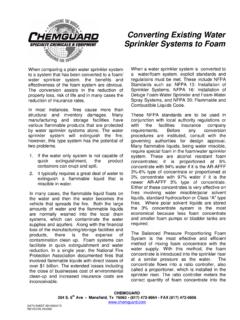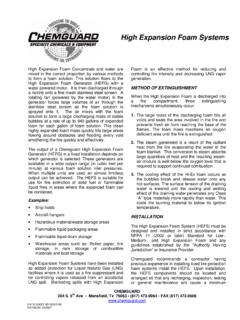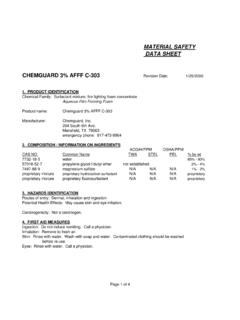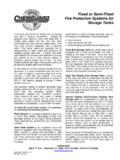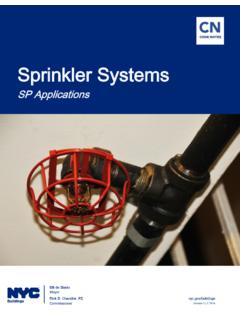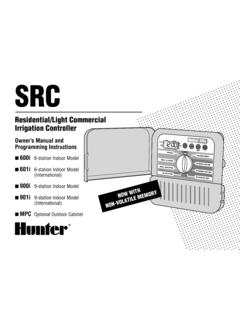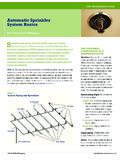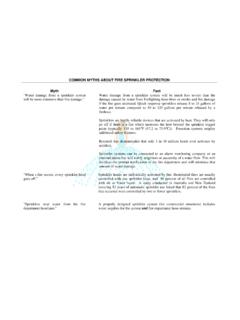Transcription of Aircraft Hangars - chemguard.com
1 Aircraft Hangars Considering the value of commercial and military Aircraft , it has become extremely important to have a reliable fixed fire protection system in Aircraft storage, servicing, maintenance and paint facilities. This fire protection system is designed to give reasonable control and extinguishment of any Class A or B type fire in the facility. Most fire protection systems for Aircraft handling facilities are designed in accordance with NFPA 409 (2001) Aircraft Hangars , or the Air force ETL 02-15 (Engineering Technical Letter) Fire Protection Engineering Criteria for Aircraft Maintenance, Servicing and Storage Facilities. Per NFPA 409 there are four basic Aircraft hangar designs that have been classified: GROUP I Aircraft HANGAR A hangar having at least one of the following features and operating conditions: An Aircraft access door height over 28 ft.
2 ( m) A single fire area in excess of 3716 m2 (40,000 ft2) Provision for housing an Aircraft with a tail height over 28 ft. ( m) Provision for housing strategically important military Aircraft as determined by the Department of Defense GROUP II Aircraft HANGAR A hangar having both of the following features: An Aircraft access door height of 28 ft. ( m) or less A single fire area not larger than 40,000 (3,716 sq. m)per hangar construction type as defined by NFPA 409 Single Fire Area Type of Equal or Greater Than But Not Larger Than Construction Sq. Ft. (M2) Sq. Ft. (M2) Type I (443) and (332) 30001 (2787) 40000 (3716) Type II (222) 20001 (1858) 40000 (3716) Type II (111), Type III (211), and Type IV (2HH) 15001 (1394) 40000 (3716) Type II (000) 12001 (1115) 40000 (3716) Type III (200) 12001 (1115) 40000 (3716) Type V (111) 8001 (743) 40000 (3716) Type V (000) 5001 (465) 40000 (3716) GROUP III Aircraft HANGAR A Group III hangar may be a freestanding unit for single Aircraft , a row hangar housing multiple Aircraft that has a common structural wall, roof system and openings for each Aircraft or an open bay hangar capable of housing multiple Aircraft with the following features: An Aircraft access door height of 28 ft.
3 ( m) or less A single fire area that measures up to the maximum square footage permitted for specific types of construction per NFPA 409. Maximum Type of Single Fire Area Construction Sq. Ft. (M2) Type I (443) and (332) 30000 (2787) Type II (222) 20000 (1858) Type II (111), Type III (211) and Type IV (2HH) 15000 (1394) Type II (000) 12000 (1115) Type III (200) 12000 (1115) Type V (111) 8000 (743) Type V (000) 5000 (465) Building construction types are defined in NFPA 220, Standard on Types of Building Construction. CHEMGUARD 204 S. 6th Ave Mansfield, Tx 76063 (817) 473-9964 FAX (817) 473-0606 DATA SHEET #D10D03140 REVISION: 09/2005 GROUP IV Aircraft HANGAR A Group IV hangar may be a member-covered, ridge, steel frame structures limited to single story height, a single fire area, used for storage and service of Aircraft .
4 FIRE PROTECTION OPTIONS Once the Aircraft hangar classification has been determined, a suitable fire protection system/ requirement can be established. There are four types of foam fire protection systems suitable for the protection of an Aircraft hangar. These systems may be used separately or they may be combined. Overhead Foam/Water sprinkler System Foam Monitor System Foam Hand Hose Line System High Expansion Foam System Overhead foam water sprinkler system can be: Closed Head Preaction Standard Wet Pipe Deluge System If used with either Protein or Fluoroprotein type foam concentrate, the foam water sprinkler heads must be air aspirating. When used with AFFF, the sprinkler heads can be standard non-air aspirating. When using Protein or Fluoroprotein foam use an application rate of of gpm per sq. ft floor area, AFFF systems shall use an application rate of gpm per sq.
5 Ft of floor area. Monitor Systems may be of the oscillating or fixed nozzle type. Oscillating Monitor Systems consist of monitors that automatically oscillate from side to side when discharging foam onto the hangar floor. They are normally preset to oscillate over a given arc to provide a flow rate over a specific area. Fixed Monitor Systems have nozzles that are typically mounted on a manifold or as single units approximately 3 feet above the hangar floor. They are preset for angle of elevation and discharge pattern to achieve the best possible stream pattern and range while keeping the stream low enough to flow under the wing of any Aircraft . This type of monitor system is often used where Aircraft or maintenance equipment in the hangar could interfere in the normal operation of the oscillating type monitor.
6 Foam Hand Hose Line Systems are required as supplementary protection in Group I and II Aircraft Hangars . High Expansion Foam Systems are designed to discharge an expanded mass of foam bubbles over the protected area to a depth of at least 3 ft. within 1 minute and flow for a minimum of 12 minutes. GROUP I HANGAR FIRE PROTECTION DESIGN REQUIREMENTS other than those housing unfueled Aircraft , shall be one of the following options: 1) A foam-water overhead deluge system. If the hangar houses single Aircraft having wing areas greater than 3000 sq. ft. A supplementary protection system consisting of either a low-level oscillating monitor system or a low-level high expansion foam system shall be provided covering the floor area beneath the Aircraft being protected. Both AFFF systems shall be designed for 10 min. operation. The system shall achieve control of the fire within the protected area in 30 seconds of the system actuation, and extinguishment of the fire within 60 seconds.
7 2) A combination of a closed-head water sprinkler system* and an automatic low-level low expansion foam system. 3) A combination of a closed-head water sprinkler system and an automatic low-level high expansion foam system. Note: The water sprinkler system for Group I Hangars is to be designed for gpm per sq. ft over any 15,000 sq. ft area. If the foam-water sprinkler system is also used for column fire protection within the hangar in lieu of the column having a fire resistive rating of not less than 2 hours, allowances must be made for the required additional foam concentrate. A reserve supply of foam concentrate must be directly connected into the system and be readily available if required. Foam-water hand hose systems shall be installed if the Aircraft that DOES NOT have drained and purged fuel tanks.
8 HIGH EXPANSION FOAM SYSTEM CHEMGUARD 204 S. 6th Ave Mansfield, Tx 76063 (817) 473-9964 FAX (817) 473-0606 DATA SHEET #D10D03140 REVISION: 09/2005 The generators should only be mounted at the ceiling or on exterior walls of the hangar where outside air only is used to generate the foam. It is recommended that the high expansion generators be installed so that the flow of foam on the floor is directed to areas immediately adjacent to, but not directly onto the Aircraft . (Please refer to the section of High Expansion Foam Systems for further information). GROUP II HANGAR FIRE PROTECTION REQUIREMENTS may be one of the following: 1) In accordance with the requirements for a Group I Hangar 2) A combination of a closed-head water sprinkler system* AND an automatic low-level low expansion foam system.
9 3) A combination of a closed-head water sprinkler system* AND an automatic low-level high expansion foam system. 4) A closed-head foam-water sprinkler system GROUP III HANGAR FIRE PROTECTION REQUIREMENTS 1) Fixed fire protection systems are not normally required 2) If any hazardous operations such as fuel transfer, welding, painting, torch cutting, etc. are performed in a Group III Hangar, the hangar should be protected as per a Group II Aircraft Hangar. GROUP IV HANGAR FIRE PROTECTION REQUIREMENTS where the hangar fire area housing unfueled Aircraft is greater than 12,000 sq. ft. 1) A low expansion foam system providing gpm/sq. ft. over the entire storage and service areas. 2) A high expansion foam system providing 3 cu. per sq. ft. over the entire storage and service areas.
10 3) An automatic water sprinkler meeting the following: a) Closed-head sprinkler meeting NFPA 13 b) Quick response water sprinkler heads c) A design application rate of gpm/sq. ft. over any 5000 sq. ft. Additional Requirement for all type Hangars Fire extinguishers must be distributed throughout the Aircraft hangar per NFPA 10 Standard for Portable Fire Extinguishers. Foam System Application Overhead primary protection systems: Discharge duration - 10 minutes Application rate - gpm per sq. ft. / AFFF through standard sprinkler heads gpm per sq. ft. / Protein, Fluoroprotein or AFFF through air-aspirating sprinkler heads A reserve supply of foam concentrate should be directly connected to the system and be readily available. If the foam concentrate is injected into the water supply by a foam pump, there are to be two pumps (one main, one reserve), either of which can provide the necessary supply of foam concentrate at the design rate.
